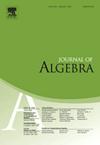Defects in weighted graphs and commutators
IF 0.8
2区 数学
Q2 MATHEMATICS
引用次数: 0
Abstract
Let R be a commutative ring. In [5], the authors introduced R-weighted graphs as a tool for studying commutators in groups and Lie algebras. These graphs are equivalent to a system of balance equations, and their consistent labelings correspond to solutions of this system of balance equations. In this article, we apply these ideas in the case when R is a field F. We focus on F-weighted graphs with four vertices and establish necessary and sufficient conditions for the existence of a consistent labeling on them. A notion of defects in weighted graphs is introduced for this purpose. We prove that defects in weighted graphs prevent Lie brackets from being surjective onto the derived Lie subalgebra. Similarly, these defects prevent certain elements in the commutator subgroup of a nilpotent group of class 2 from being a commutator. As an application of our techniques, we prove that for a Lie algebra L whose derived subalgebra is at most 3-dimensional, the Lie bracket is surjective onto . We provide a counterexample when . We also characterize commutators among the elements of L' when .
加权图和换向子的缺陷
设R是一个可交换环。在b[5]中,作者引入了r加权图作为研究群和李代数中的交换子的工具。这些图等价于一个平衡方程组,它们的一致标记对应于这个平衡方程组的解。在本文中,我们将这些思想应用于R是域f的情况下。我们关注具有四个顶点的f加权图,并建立其上存在一致标记的充分必要条件。为此,引入了加权图中缺陷的概念。证明了加权图的缺陷使李括号不能满射到派生的李子代数上。类似地,这些缺陷阻止了2类幂零群的换向子群中的某些元素成为换向子。作为我们技术的一个应用,我们证明了对于其派生子代数L ‘最多为三维的李代数L,李括号是满射到L ’上的。当dim (L ')=4时,我们给出了一个反例。当dim (L/Z(L))≤4时,我们还描述了L'元素间的交换子。
本文章由计算机程序翻译,如有差异,请以英文原文为准。
求助全文
约1分钟内获得全文
求助全文
来源期刊

Journal of Algebra
数学-数学
CiteScore
1.50
自引率
22.20%
发文量
414
审稿时长
2-4 weeks
期刊介绍:
The Journal of Algebra is a leading international journal and publishes papers that demonstrate high quality research results in algebra and related computational aspects. Only the very best and most interesting papers are to be considered for publication in the journal. With this in mind, it is important that the contribution offer a substantial result that will have a lasting effect upon the field. The journal also seeks work that presents innovative techniques that offer promising results for future research.
 求助内容:
求助内容: 应助结果提醒方式:
应助结果提醒方式:


